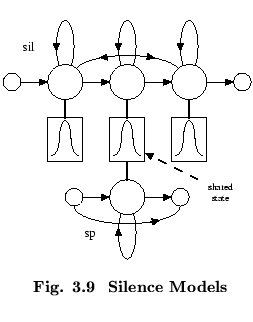
The previous step has generated a 3 state left-to-right HMM for each phone and also a HMM for the silence model sil. The next step is to add extra transitions from states 2 to 4 and from states 4 to 2 in the silence model. The idea here is to make the model more robust by allowing individual states to absorb the various impulsive noises in the training data. The backward skip allows this to happen without committing the model to transit to the following word.
Also, at this point, a 1 state
short pause sp model should be created.
This should be a so-called tee-model
which has a direct transition from entry to exit node.
This sp has its emitting state tied to the centre state of the silence model.
The required topology of the two silence models is shown in Fig. ![]() .
.
These silence models can be created in two stages
HHED works in a similar way to HLED. It applies a set of commands in a script to modify a set of HMMs. In this case, it is executed as follows
HHEd -H hmm4/macros -H hmm4/hmmdefs -M hmm5 sil.hed monophones1
where sil.hed contains the following commands
AT 2 4 0.2 {sil.transP}
AT 4 2 0.2 {sil.transP}
AT 1 3 0.3 {sp.transP}
TI silst {sil.state[3],sp.state[2]}
The AT commands add transitions to the
given transition matrices and the final TI command creates a tied-state called silst. The parameters of
this tied-state are stored in the hmmdefs file and within each silence
model, the original state parameters are replaced by the name of this
macro. Macros are described in more detail below. For now it is
sufficient to regard them simply as the mechanism by which
HTK implements parameter sharing.
Note that the phone list used here has been changed, because the original list
monophones0 has been extended by the new sp model. The new
file is called monophones1 and has been used in the above HHED
command.
Finally, another two passes of HEREST are applied using the phone
transcriptions with sp models between words. This leaves the
set of monophone HMMs created so far in the directory hmm7.
This step is illustrated in Fig. ![]()